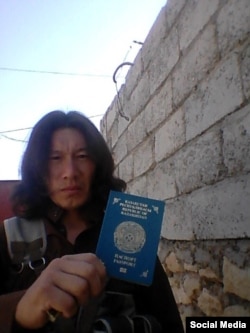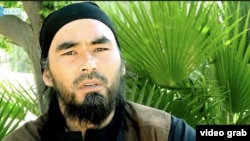The militant group Islamic State (IS) has stepped up its Russian-language propaganda efforts, another sign that its Russian-speaking contingent is becoming more powerful.
Though Russian-speaking IS militants have put out their own propaganda for some time, in recent weeks a new Russian-language IS media wing -- Furat Media -- has emerged that appears to have taken on official, or at least semiofficial, status within IS's overall media operations.
IS currently produces official propaganda messages in Arabic, English, Kurdish, French, and Russian, according to Aaron Y. Zelin, an analyst with the Washington Institute for Near East Policy.
And though IS has not made any specific announcement declaring that Furat is an official IS media wing, Zelin says it is an "unofficial official account."
Furat has opened accounts on Twitter, Facebook, and the Russian social network VKontakte and maintains a website, Furat.info, through which it disseminates various forms of IS propaganda, including video messages by Russian-speaking militants and Arabic- and English-language videos dubbed into Russian.
Furat, whose name comes from the Arabic word for the Euphrates River, even has its own logo, a blue square with two white, wavy lines suggesting water.
Formalizing Operations
That Russian-speaking militants in Syria are disseminating propaganda is nothing new.
The various factions of militants -- including those fighting alongside IS as well as individual factions -- have had their own websites and social-media accounts almost since they first emerged in Syria in late 2012.
But as IS's Russian-speaking faction has grown in prominence -- and in numbers -- it has transformed its media operations from piecemeal efforts by what appeared to be a handful of militants into an increasingly slick and semiprofessional operation.
The main precursor to Furat began life around early 2013 as FiSyria, a website run by a group of Chechen militants led by Umar al-Shishani, an ethnic Kist from Georgia's Pankisi Gorge. At first, FiSyria was effectively Shishani's personal site, offering news about battles he and his fellow Chechen militants were involved in.
But when Shishani moved on to bigger things -- he is now IS's military commander in Syria -- FiSyria changed, too.
After Shishani swore an oath of allegiance to IS leader Abu Bakr al-Baghdadi and moved over to IS with a group of militants in late 2013, FiSyria went with him and became a Russian-language IS propaganda website.
Now, FiSyria redirects to Furat's website.
Furat also seems to have swallowed another IS media group, ShamToday, which was previously active on Russian social media and which was run by a group of North Caucasian militants.
Increased Output
Furat has significantly increased the volume of IS propaganda available to Russian-speakers, primarily by publishing existing IS videos with Russian subtitles.
But to do this, the group will have had to recruit additional "staff" who have a good enough understanding of spoken Arabic to allow them to translate the videos into Russian.
Clues of how IS's Russian-language media operations work can be found on social media, where Russian-speaking militants have posted photographs of IS media offices.
A Kazakh IS militant who goes by the name Artyom posted a photograph of what he said was an "IS Media Center" on July 1. The photograph shows Artyom and another militant sitting in an office with laptops and cellphones.
Not Just Chechens
The presence of Artyom, who is based with a Russian-speaking IS contingent in Mosul, in an IS "media center" is another sign that IS's Russian-language propaganda efforts are changing and growing.
In the past, Russian-speaking IS propaganda efforts appeared to be run primarily by and for North Caucasian militants.
Recently, however, Central Asians have also been photographed undertaking IS propaganda work.
Prominent Tajik militant Abu Daoud (real name Parviz Saidrakhmonov) has been photographed several times working in an IS "Media Center."
Saidrakhmonov, who is thought to have been killed, has been linked to several prominent Russian-speaking IS ideologues, including Daghestani preachers Akhmad Medinsky and Nadir Abu Khalid. Both Daghestanis are close to Abu Jihad, an ethnic Karachay who is Shishani's close confidante and who has been involved in IS propaganda efforts for many months -- and who is likely one of those behind Furat Media.
Recruitment And Retention
Furat's work has two main purposes.
First, it is dedicated to recruiting new Russian-speaking militants, both from the Russian Federation -- particularly the North Caucasus -- and from elsewhere in the former Soviet Union, especially from Central Asia.
Furat is also engaged in spreading IS messages to Russian-speaking militants who are already fighting alongside the group, both via social media and by creating and sending CDs containing Russian-subtitled IS propaganda videos to various Russian-speaking militant groups in IS-controlled territory.
A July 1 Facebook post included photographs of one batch of CDs with an explanation that these were for "brothers in the caliphate," the term used by IS for territory under its control.
By translating Arabic-language material into Russian, Furat is able to ensure that all Russian-speakers in IS-controlled territories have access to the same messages and ideology as their Arabic-speaking counterparts. So, too, can potential recruits back home in the Russian Federation or Central Asia.
Furat is also playing an important role in building ideological bridges between militants in Syria and Iraq, and those who are still in the North Caucasus.
It was Furat which announced that IS had declared the establishment of a "province" in the North Caucasus. The propaganda wing also issued a professionally produced video, Unity Of The Mujahideen (Jihad Fighters) Of The Caucasus, which included interviews with Russian-speaking militants in Iraq and Syria who praised the pledges of allegiance to IS by North Caucasians.
Resilience
Although there have been efforts by social-media websites like Facebook and Twitter to crack down on pro-IS accounts, Furat has so far been resilient.
Furat's Facebook account has already been banned, but the group opened a new one -- this time a closed group -- on July 1. By July 2, the group had 87 members.
And while several countries, including Russia, Kazakhstan, and Tajikistan, have banned pro-IS and other Islamist websites, they have been less successful in blocking social media.
A group of websites listed by the Tajik Interior Ministry on July 2 as being banned does not include Furat Media's site or its social-media accounts.


